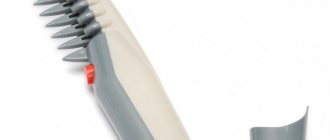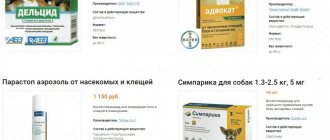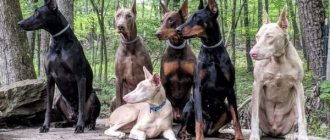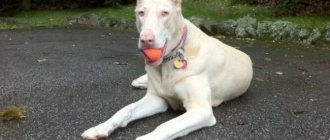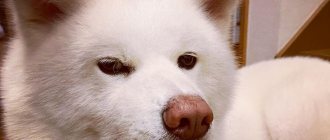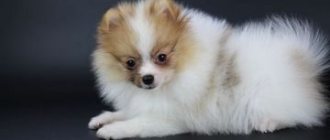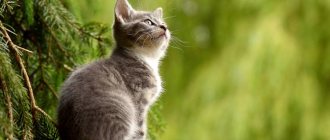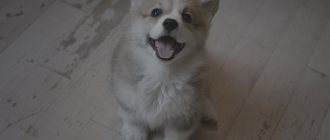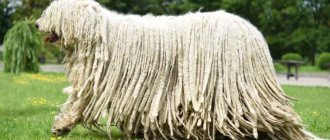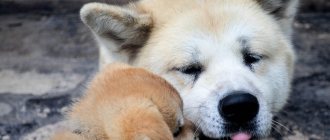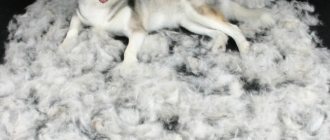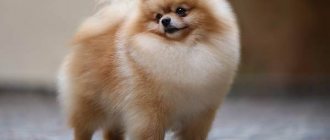When getting a dog, few people realize what difficulties await them.
The dog needs to be fed, walked with, and also looked after, keeping it clean and tidy. Caring for the external condition of a dog consists primarily of taking care of the condition of its coat. This takes quite a lot of time. Dog hair needs to be combed using special combs and brushes, which we will talk about in more detail in this article. After reading it, you will learn everything about dog combs - what they are and which one to choose specifically for your dog and its coat type.
What are they needed for
Combs are used not only for beautifully styled and separated wool. They help remove old fur, facilitate and speed up shedding, and untangle knots and tangles. They are also necessary for styling long locks of breeds such as Italian Bolognese, Finnish Spitz, Yorkshire Terrier, Greater German Spitz, Afghan Hound and other dogs with long or voluminous hair. For pets with a hard curl (Fox Terrier, Scottish Terrier, Miniature Schnauzer, etc.), there are furminator combs with blades to remove old undercoat and thin out the coat.
How to brush your dog’s teeth at home and what products, besides a toothbrush and toothpaste, are needed for this
Is this a replacement for a haircut?
Some owners of wire-haired dog breeds believe that trimming and cutting are the same thing, without delving into the meaning of the procedures. These methods of processing wool have different purposes, so it cannot be replaced by cutting.
Trimming is a forced hygienic procedure that helps remove dead hairs, thereby ensuring the growth of new hairs with the correct structure.
During the cutting process, only the tops of the coarse guard hairs are removed down to the base, but the structure of the coat changes greatly. The cut hair with a thin base continues to grow and the animal eventually breaks into soft downy thin hair. Even a single haircut of a dog can lead to irreversible consequences and loss of the type of coat characteristic of the breed.
Types by purpose
There are many options for using combs, and today there is a large selection of models with different purposes. Some of them have a specific design and require special skills, such as those of experienced groomers (masters in caring for dog hair). Other models are suitable for home use and are absolutely safe for the pet and its owner. Combs can be divided into several groups according to their purpose:
Cord with a handle for combing out the undercoat of long-haired dogs
For combing out hair: combs and “rake” with rare teeth, massage.- For combing out the undercoat: “rake”, combs with fine teeth.
- For combing out insects: mini-combs with very frequent and long teeth.
- For massage: massage combs with a rubber base and spring teeth.
- For styling: massage brushes with a flat and wide base, closely spaced teeth. Or hard bristles are placed around a long base.
- For trimming (removing hard hairs): combs with blades, coat kings (“rakes” with short and wide teeth with movable elements).
- For detangling wool: tangle cutters (“rakes” with blades).
Most combs have multiple uses, with the exception of bladed models and tangle cutters. It all depends on the thickness of the coat, its length and the goal. For styling, not only brushes are used, but also combs on dogs with long and smooth strands. Massage combs are useless on wire-haired dogs, but fine-tooth combs are very effective.
Warning! Models with blades in inept hands can damage the fur, which will then take a long time to grow back. For breeds with long strands or rigid curls, this is fraught with loss of aesthetic appearance and damage to the hair structure.
Features of the coat
As you know, a dog’s hair consists of the undercoat and the fur itself. Dogs need undercoat to retain body heat in bad weather, and wool forms the appearance of the pet, and also serves as protection from the sun, wind, rain and other environmental factors.
IMPORTANT! Different breeds of dogs have different proportions of undercoat and fur, so some dogs can sleep in the snow in severe frost, while others freeze in a slight wind in the fall.
Dogs are very clean animals and do most of the work of cleaning their fur on their own, but cannot cope with mats or tangled hair that sometimes form.
Caring for a dog's coat involves combing, washing and sometimes cutting it. You can wash your dogs rarely, no more than once a month, so as not to wash away the natural balance. But it is recommended to comb the fur often, using special combs or brushes. With their help, the loose undercoat is combed out and parasites are removed from the fur. How often you need to brush your dog's coat depends on whether your dog has short, long or smooth hair.
Smooth-haired dogs are the easiest to comb. They have virtually no undercoat, and their hair is short, so they hardly get tangled. Short-haired dogs have a small undercoat, and the hair can become tangled if the dog gets dirty. Long-haired dogs may have an abundant undercoat and long hair, on which, in addition to tangling, tangles may also appear if the pet is not properly cared for.
Separation by wool length
Of course, tools for some breeds will not be the best choice for others. First of all, the design of combs is influenced by the length and structure of the dog’s hair.
Smooth-haired and short-haired breeds
Massage combs, and especially mittens, are suitable for them. They are used during the molting period, when washing and simply for pleasant stroking, if the pet likes it. “Rakes”, combs are useless in this case, because they do not grab short hair. An exception, but extremely rare, is kennel dogs such as Rottweilers, which in the cold season, when kept in this manner, grow a thick and rather long undercoat.
Comb for combing facial hair
For long hair
For such dogs, combs with a medium frequency of teeth are selected for daily combing of strands. With a close location and short length - to sort out thin tangled hairs behind the ears, in the groin, armpits, and on the ears.
Styling and pulling out strands is done using massage combs while drying with a hairdryer or compressor. It is convenient to comb out thorns and dirt using combs with large, widely spaced teeth.
For trimming wirehaired dogs
Such dogs are treated in everyday life with a “rake” to remove some mature hairs and untangle fresh curls. Coat kings were created for trimming or stripping (plucking off dead hairs). Other types of tools will not penetrate the thick and rough cover. If the coat is soft, and this happens in all breeds from this group, then you can comb it with a sparse comb and massage options with large pins. In some cases, it is better to use a special trimming knife.
Show Tech (Belgium)
The trimming stone looks like pumice, and the surface is just as porous. A rectangular tool, used for plucking dead hairs at the final stage of processing soft coats and undercoats (spaniels, setters). According to reviews from dog owners, this tool copes with the task well, but black dust from the stone remains everywhere. Costs about 300-400 rubles.
For pets of different sizes
The size of the dog practically does not play a role in the selection of combs; here they are guided by the type of coat. However, the smaller the pet, the smaller the tool should be. And small dogs weighing up to about 5 kg, such as the Prague Rat, rarely have coarse wild-type hair, like German Shepherds or St. Bernards, therefore, in their case, fine combs and massage models are relevant, and long-haired Japanese Spitz dogs are conveniently treated with massage combs with long stilettos.
For your information! Large combs intended by the manufacturer for small dogs may also be suitable for large breeds. With such tools they can treat areas with soft and always tangled hairs.
Criterias of choice
Our site reminds you: brushes are chosen for the specific type of coat and characteristics of the dog. The functional classification describes the types of tools for a particular task. For example, the Afghan Hound needs brushes with natural or wooden bristles and an antistatic effect. For the smooth-haired Great Dane, models in the form of rubber mittens are ideal.
It is important to pay attention to the material of the product; wooden ones usually prevent static electricity from appearing and do not delaminate the hair. For coarse wool, it is better to choose synthetic models that are durable. The fluffy hair of the Samoyed dog is removed with a slicker brush with sparse teeth and a wide base. Also, the ends of metal or synthetic bristles should have drop-shaped tips. The longer the teeth, the thicker the wool they can process. Small brushes are suitable for dogs of modest size.
Types of construction
This grooming tool is available in only a few types, but each of them also has additional elements. Such know-how greatly simplifies caring for a pet and makes the owner’s work easier. The main types of dog combs according to their design are divided into:
- “Rake” - on a handle made of plastic, wood or metal, teeth are located perpendicular to it.
- With rotating teeth - a subtype of “rake” with movable teeth.
- A comb is a flat product made of metal, plastic (very rarely) or wood with one row of teeth. There are double-sided options with different tooth frequencies.
- Massage and brushes - a wooden, plastic, metal handle and base with a rubber cushion on which pins are placed. There are double-sided ones with different bristles.
- Mittens - rubber mittens with a palm mount and studs, like massage models.
- With blades - “rakes” or combs in which cutting elements are deepened between short teeth. They grab a small part of the wool, while simultaneously disassembling it with teeth. Also braid cutters with extended pins and a shortened body.
Where can I buy
If suddenly the stores in your city don’t have a suitable comb or you simply don’t have time to look for it, then you can always place an order online. Online stores provide a huge selection of various accessories for animals at fairly affordable prices. The only negative that can be highlighted is the waiting time for the order.
Best online pet supply stores:
- Lemurrr pet market chain;
- Section with combs for dogs on Aliexpress;
- Online store of pet products Zoo Passage.
Manufacturer brands
There is no point in describing all the existing brands that offer this tool. In this article we will talk only about the most popular of them.
Artero
From the manufacturer Artero
Combs with metal, plastic and wooden handles for combing and removing fleas. There are models with two rows of teeth, beveled and without handles.
A total of 10 models mainly for medium and large breeds. The cost of a tool of this brand is usually in the range of 400-1600 rubles.
Massage room produced under the Maxi Pin brand
Maxi Pin
Beech massage combs with rosewood coating. Models with wooden and metal rounded studs. There are 3 sizes of each type in the catalogs, among them there is a pocket version.
The length of the studs is 21-35 mm. The most popular model is with a stud length of 25 mm. Choose from a soft or hard rubber cushion. The average cost is 800 rubles.
Trixie
From the manufacturer Trixie
A very wide range with affordable prices. 8 types of “rakes”-scrapers with a rubber lining on a metal handle: with rotating teeth, double-row, pin length 15-20 mm. 21 types of combs with and without handles, wooden, plastic or metal body with rubber lining.
There are combs with rotating teeth, double rows and different sizes on one side. The length of such combs is 180-220 mm. The average cost of a rake is 450 rubles, combs are 150-300 rubles.
What are combs for?
A comb in the form of a comb is needed to thoroughly comb out the fur coat. The stuffed coat of a Spitz cannot be combed with just a massage brush.
The comb helps capture dead fluff. It allows you to get rid of hairs that the slicker could not capture. This tool combs tangles well. Used as the main tool for everyday grooming.
A comb is also indispensable when grooming a dog - it helps to draw out the hair.
Contraindications
Whirling teeth are the enemy of long or medium wavy coats. The strands are wound around a moving element and then have to be cut with scissors. Tangle cutters also cut wool, so they are used as a last resort when the knots cannot be untangled either by hand with a comb or with the help of cosmetic oils. For dogs with sensitive skin or irritation, combs with metal teeth are contraindicated; it is better to give preference to wooden ones.
Original FURminator
The company produces furminators from durable stainless alloy, so the combs have been used for years. The handles do not deform, do not break, the teeth do not bend, the sharpness remains sharp for a long time, and the comb does not fall off. Manufacturers provide a 10-year warranty.
There is the right size for an animal of any size:
| Size | Ridge width, cm | Dog weight, kg |
| X-Small | 3 | up to 4 |
| Small | 4 | 4 – 9 |
| Medium | 7 | 9 – 23 |
| Large | 10 | 23 – 40 |
| X-Large | 13 | 40+ |
Combs marked Short hair are used for short-haired dogs with hair length less than 5 cm, and those marked Long hair are used for long-haired animals. In the first version, the teeth are slightly shorter. All FURminator models have a button to reset the combed hair.
Classic instruments with manual hair removal are no longer produced. In the new models, only the design has changed: the body has become more streamlined, the working surface remains the same.
Operating rules
To comb out the undercoat of long-haired dogs,
take the comb in your hand and comb each strand separately. If the hair is tangled or has thorns on it, then first go through the hair with a “rake” with very rare teeth.
They comb the entire body, the feathers on the paws, and the tail gently and neatly. Using fine-toothed combs, treat the area behind the ears, the beard of wire-haired animals, and the armpits, after first lifting the spine.
Tangles and knots must be sorted out by hand before combing.
Advice! Use any comb only according to the growth of the coat. Only when laying it is permissible to slightly raise the spine and downs with massage brushes in breeds with a thick and voluminous coat.
To comb out the undercoat with a “rake” with regular or rotating teeth, first run the tool along the body, and then make small partings to raise the awn. Then the matured fluff is processed along these partings. Periodically, the collected hair is removed from the teeth so that the tool captures more hairs.
Coil cutters are used with extreme caution. It is necessary to separate the coat from the undercoat and matted hair from the rest. Then the teeth of the tool are placed under the base of the tangle, as if prying it up, and gently pull this tangle away from the roots of the hairs. Then the matted fur is cut off, practically without damaging the rest. Coat Kings work on wire-haired dogs by running a tool along the body. It is necessary to clean the blades and teeth when they become clogged with cut hairs.
Massage combs are also guided according to the growth of the coat. Models with short hairpins (up to 1 cm) or mittens are suitable for use during washing. In addition to hair removal, the dog will receive a relaxing massage, and the shampoo will foam better and be distributed throughout the body. These combs are used after the cosmetic product has been applied to the body and paws. With the help of massage models, it is easier to accustom puppies to grooming and hygiene procedures. Simply move them along the growth of fur on the back and sides and thus strengthen the “combing = positive emotions” connection.
Laying with brushes requires skills and preliminary experiments. For Yorkshire Terriers, the washed coat is dried on top with a hairdryer at medium power and temperature, while simultaneously pulling out the strands with a flat massage comb with fine pins on the back side (the hand with the tool should be near the pet’s body). To create volume in a Samoyed dog or Pomeranian, use a flat brush to slightly lift the undercoat, holding the comb perpendicular to the coat. Round models are used at the ends of the Shih Tzu's strands, similar to the pulling of Yorkshire Terriers.
Recommendations
It is necessary to accustom a Spitz to combing its hair from childhood. The first procedure is carried out in 1 month.
Before bathing, the Spitz is combed. This will prevent the undercoat and rugs from becoming felted.
Before combing your Spitz, the coat must be moistened with a conditioning spray. This will avoid damaging your pet's fragile outer coat.
It is recommended to comb your Spitz up to twice a week for 15 minutes. During the period of active molting, the procedure can be carried out daily.
After combing, the fluffy is carefully processed. Encouragement will help your pet tolerate care in the future.
Source
Was this article helpful?
Thank you for your opinion!
The article was useful. Please share the information with your friends.
Yes
No
X
Please write what is wrong and leave recommendations on the article
Cancel reply
Rate the benefit of the article: Rate the author
Discuss the article:
Instrument care
Wash combs with antibacterial or laundry soap after each use. Then be sure to dry it in the sun and fresh air or under a hot and powerful stream from a hair dryer. To clean massage models of hairs, use a “rake” or other unnecessary comb to comb out the hair between the teeth. At home, disinfection by treatment with medical alcohol or hydrogen peroxide is also desirable. In grooming salons, it is mandatory to immerse tools in ultraviolet devices for disinfection.
How much do groomer services cost?
When talking about grooming prices, you should definitely take into account the region and level of the salon.
So in Moscow and the Moscow region, prices for a haircut range from 1200 to 1800 rubles. Combing will cost about the same. Prices for comprehensive grooming can vary from 2000 to 5000 rubles, and sometimes higher.
What is included in the service package:
- bathing;
- blow drying;
- a haircut;
- combing;
- nail trimming;
- teeth cleaning;
- ear cleaning;
- eye care.
How to choose the right one
Advice: combs should be selected according to the type and length of the coat, the size of the dog and personal preferences. Yes, a comfortable handle is an important factor, because when handling a pet, the wrist and forearm are very strained. Because of this, the criteria for selecting a quality comb look like this:
- comfortable handle - try to take it in your hand and make a couple of dozen movements simulating combing thick fur;
- absence of nicks in the body, splitting on the teeth - solid metal must be free of rust, scratches and other defects;
- size and purpose - small combs are convenient for walks and trips, large combs are faster and more convenient to process wool;
- antistatic effect - manufacturers usually indicate this on the product itself.
And, do not forget that each dog and its living conditions are individual. Therefore, it is advisable to try several options to settle on the best. In addition, the structure of the coat may change at different periods of life. So, in puppyhood (up to about 9-12 months from birth) it is softer and more fluffy, as in old age (from 8-9 years). After childbirth and illness, changes are also observed. And tools purchased but never used may come in handy in the future.
What care is required for dogs' claws and paws in summer and winter, as well as what tools will be needed
Advantages and disadvantages
The main advantages of high-quality brushes for dogs include ease of use. It is also worth noting their durability, quick and easy cleaning.
A wide range of modern manufacturers allows you to choose a model that is suitable even for dogs with a special coat structure. Durability is another positive aspect, as the tool usually lasts for several years.
The downside to dog brushes is that sometimes you have to try several models to find the perfect one. Some slickers scratch the skin, and “massages” cause irritation. The cost of professional tools most often makes them inaccessible to ordinary owners.
Expert advice
Before buying a comb, visit a dog show where there are owners of similar breeds. You can find out from them which combs are most often suitable for pets with a certain type of coat. This advice is especially relevant if the dog requires complex and constant grooming. At exhibitions they often sell branded and rare instruments that cannot be found in a regular pet store.
Here you will find the 2022 CAC Dog Show Schedule.
For your information! Today there are many master classes from famous groomers, where you can learn not only about choosing a comb, but also special tricks for using it.
What will you need?
If you decide to cut your dog’s hair at home, then you can’t do without special tools:
- medium-sized hairdressing scissors;
- special comb for cutting;
- slicker;
- brushes and combs for dogs;
- trimmer or special machine;
- standard height table;
- a rubber mat or thick fabric for the dog’s comfort;
- good lighting.
Smooth-haired dog
Representatives of such breeds as Doberman, pug, bulldog or boxer need to be treated in a gentle way, after about 2-3 days.
- Dog breeders are interested in how to comb a smooth-haired dog, so as not to cause inconvenience to it with the wrong tool.
- Experts recommend a brush with bristles or a rough massage mitt.
- Sometimes you can use a metal brush to remove loose hairs.
- The fur on such a dog will shine if you wipe it with flannel.
Combing procedure
The dog needs to be put down, seated or stood. Her body position changes as the furminator advances. You need to start combing carefully, without tugging or scratching the skin, moving your hand in the direction of hair growth. Particular care should be taken to comb the area under the tail, the belly and the inside of the hind legs. The dog can twist and pull out, since these places are highly sensitive to him. The rest of the dog's body is more willing to be brushed.
Animals with not very long hair need to be combed from top to bottom. A long-haired dog is combed “in layers”, from bottom to top, moving higher only when the entire row below is combed. After getting used to working with the tool and if the dog does not resist, the fluffiest pet can be combed out in 20-30 minutes.
They associate a quick treatment of a dog with a pleasant massage; over time, they willingly approach and stand calmly throughout the entire procedure. At the end of work, the furminator for dogs should be carefully washed with warm soapy water. You cannot use abrasives, wet wipes, or sponges for cleaning, as this will dull the blades.
